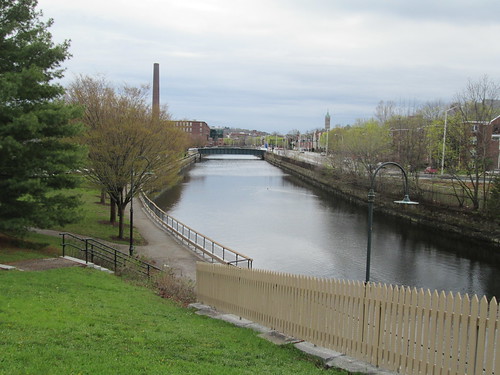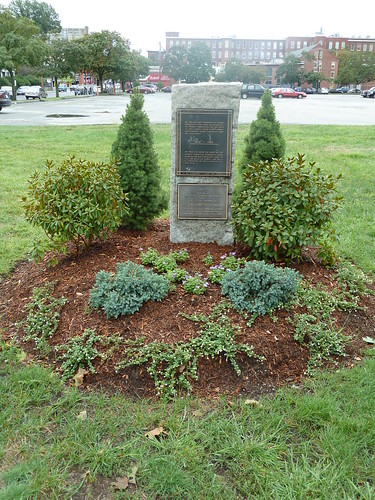Lowell at the Urban Renewal Symposium

Northern Canal Urban Renewal District
Last Saturday I attended a program sponsored by the Lawrence History Center called “Reclaiming Urban Renewal: Community Efforts and Impacts in Lawrence, Massachusetts and other Industrial Cities.” At the event, I attended a fascinating breakout session on Urban Renewal in Lowell that featured Peter Aucella, Fred Faust, and Chuck Parrott (the long time architect of the Lowell National Historical Park). This session was moderated by Paul Marion and it presented many insights into the development of Lowell over the past fifty years.
In my Sunday “Week in Review” post, I summarized the keynote speech by Harvard history professor Lizabeth Cohen (also the Dean of the Radcliffe Institute) and recounted the Lowell panel’s comments on the Lowell Connector. But there was much more about Lowell in that session, so here are the notes I took on that topic.
Chuck Parrott argued that Lowell’s first Urban Renewal Project came in the 1930s when the Greek neighborhood of the Acre was torn down to make way for the North Common Village public housing project. Under the New Deal, local housing authorities were created to build affordable housing (like the Lowell Housing Authority). Legislation in 1937 created housing and control of it at the local level. The Greek neighborhood was replaced by brick row houses, however, much of the Acre was saved from demolition but there has been an ongoing effort since then to preserve historic structures.
By the 1950s, Lowell struggled to compete with suburbs. Downtown Lowell was still a “going concern” into the 1970s, but the danger signals were visible even before then. To maintain the viability of downtown, planners had to deal with the automobile. This led to the creation of a number of large surface parking lots on the sites of demolished mills that provided about 2000 spaces (some published documents talk of 8000 spaces in downtown, but Parrott believes this would include every possible parking space, not just the lots.
Urban Renewal really began in Lowell in the 1950s (Federal legislation in 1949 and 1954). The city was quick to respond, designating Little Canada and the corporate housing of the Merrimack Manufacturing Company as the Northern Canal Urban Renewal project.
A corollary of the Urban Renewal projects was how to service them for automobiles. Route 3 had already been built and Rte 495 was under construction. The Lowell Connector was intended to be the “redevelopment spine” of the city although the middle section of it was never built.

Little Canada monument
Little Canada was a residential neighborhood of densely packed houses. Many of them were 4 stories tall even though traditional urban structures only had 3 floors.
Urban Renewal did not include the demolition of the mills themselves, however, after the last of the mills failed (Boott in 1954 and Merrimack in 1957), the owners of the mills decided on their own initiative to demolish some of the mill buildings. This private demolition magnified the area of Urban Renewal demolition.
All of this demolition “left a huge gap in the cityscape.” The demolition of the “long block” on Dutton Street set the new agenda for preservation. The construction of the middle section of the Lowell Connector would have prompted the demolition of the Massachusetts Mills. The fight against the Connector wasn’t about that (it was about saving the Back Central neighborhood) but the Connector fight did have enormous consequences for the preservation of the mills.
Fred Faust was the next speaker. He said planners in the 1960s and 70s were “desperate to make cities more like suburbs.” He also said that many local private interests had close ties to the Kennedy Administration and these interests grabbed control of a lot of the local redevelopment authorities. One goal was to reduce density and the targets were the neighborhoods that were the least politically active. Fortunately for posterity, the leadership of these efforts “didn’t have its act together” otherwise even more of the city would have been demolished.
Lowell had an unemployment rate of 13% and people were desperate to do something. In this context, a group started by Pat Mogan started saying “there is value in the Lowell story.” There was push back because the exploitive nature of the mills created a negative attitude in the city and about the city by many of its residents.
Some other points made by Fred: He said “Jane Jacobs got it right when she said that cities do well when they have something for everyone.” He also said that “top down” planning without community input never succeeds. He said that the most successful projects begin with a core of supporters who build community support which then attracts public officials to the cause.
Fred differed from Dean Cohen by saying that the mix of public and private funding and control was essential to Lowell’s success. He said that Lowell’s revival began with the Human Services Corporation that emphasized the importance of culture and heritage. He said it was no coincidence that besides Mogan, two of the leaders of HSC were Peter Stamas and Lillian Lamoureaux who were from the Greek and French communities, two groups that had been displaced by earlier Urban Renewal projects. The mantra of HSC was “our history is important; we should share it.”
Fred then showed the 1972-74 “Brown Book” that was a concession from Nixon to then Congressman Paul Cronin. Nixon didn’t want to fund a National Park for Lowell so he funded a study intending that to kill the project. However, the Brown Book ended up being the blueprint for the legislation that created the national park.
The NPS opposed the Lowell park initially because they were concerned that every city would want a park and that too much NPS funds would go to urban parks and natural places would be neglected. But, the Lowell advocates argued that there was a legitimate reason for the park: to tell the story of industrialization in America and to preserve our immigrant history. The initial park service plan was for five buildings but Tsongas created the preservation district that made much of downtown the park while leaving properties under private ownership.
The next speaker was Peter Aucella. He emphasized that the bulk of what of what was done was private sector development. He said a big issue in doing what happened in Lowell was to have the political will to do it and strong support from the local media. The challenge was that all this private investment had to be done in a way consistent with federal investment. Lowell did this through a strong local historic commission. He showed a number of photos of downtown buildings that were “modernized” by covering up their original brick and granite with aluminum and other similar materials that have since been removed.
In response to a question, Peter said the city manager form of government has helped the city’s development. He said with a strong mayor, the new mayor has always campaigned on doing something different than the old mayor, so each new administration brings different priorities and objectives and often stuff doesn’t get done. When a city manager gets selected by the council, there is already support for ongoing projects in the business community, the National Park, and other institutions and entities that provide continuity. It’s easiest for the new city manager to just go along with the momentum rather than start something completely different. He also said that continuous leadership from neighborhoods, religious institutions, and other non-governmental entities helps tremendously. And success does breed success.
Great post.
Jane Jacobs notes in her book Cities And The Wealth Of Nations that Lowell is a transplant city created by the economy of Boston. Meaning businesses, the mills, located here but control and money was in and flowed to Boston. Transplant cities are vulnerable because when more favorable opportunities arise the businesses leave. Hence the mill businesses moved south to new transplant cities. Then the mills moved from the southern transplant cities to overseas transplant cities. It never really ends.
Left in its wake is massive unemployment and decline. Transplant cities enjoy great riches when things are good but when they fall, as is inevitable in all transplant cities, they fall hard.
Jacobs posits that the only way to break the cycle is become a import-replacement city. By replacing imports that we currently buy with products and services we can sell to ourselves and others. These import-replacing companies shouldn’t be in one industry like cotton or computers(Wang) because specialized and efficient economies are vulnerable to other import-replacing cities who may create a better product.
Diversity and the number of import replacing companies a city can produce makes a city economy resilient and vigorous. This is why I believe it’s important that we eliminate the minimum parking requirements in downtown and the surrounding neighborhoods. We need to appropriate as much space as possible to creating new businesses and housing. Mandating space for car storage reduces the likelihood of Lowell becoming and import-replacement city.
I’m not done reading the book but it is amazing. I should have it back to the Pollard within a week if anyone is interested in reading it.
Interesting. Nothing on the Central Plaza?
Thank you for this interesting and informative report. I was supposed entertained and educated.